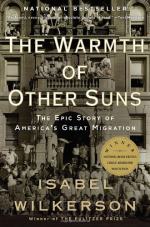|
This section contains 681 words (approx. 2 pages at 400 words per page) |

|
The Warmth of Other Suns Summary & Study Guide Description
The Warmth of Other Suns Summary & Study Guide includes comprehensive information and analysis to help you understand the book. This study guide contains the following sections:
This detailed literature summary also contains Topics for Discussion on The Warmth of Other Suns by Isabel Wilkerson.
The Warmth of Other Suns, The Epic Story of American’s Great Migration by Isabel Wilkerson is the story of the migration of southern blacks to the urban areas of the North and West in hopes of finding a better life for themselves and their families. The Great Migration began in 1915 and continued steadily until the 1970s when all the vestiges of discrimination and racism in the South finally began to vanish. During those many decades, six million black southerners made their way from the Deep South to the North and West to escape Jim Crow laws and to forever leave behind the racism that was oppressive and all-encompassing. Some historians believe that the number of migrants was far greater than six million because there was no formal recordkeeping and many of the departures were secretive and in the dark of night.
The Warmth of Other Suns begins with a personal anecdote from author Isabel Wilkerson. She is a second generation descendent of a southern black migrant. Her grandmother fled from the Jim Crow south in favor of a more level playing field up north. Wilkerson heard many stories over the years about the unbearable conditions in which blacks were forced to exist. She also heard how the decisions to leave were heart-wrenching – the migrants were leaving so much behind – family, friends, memories, their hometowns. Wilkerson also learned of what it was to be flung into what was the equivalent of a foreign land for many of the migrants. People in the North were fast-talking with strange accents; everything was crowded; the food was unfamiliar; and, the migrants had to deal with snow and cold temperatures and homesickness.
The Warmth of Other Suns focuses on the migration of three real-life individuals. Ida Mae Gladney, her husband, George, and their two young children fled in the dark of night from the cotton fields of Chickasaw County, Mississippi, to Milwaukee and then on to Chicago. George Starling escaped the citrus fields of Eustis, Florida, and a possible lynch mob when he hopped a train for New York City. Dr. Robert Pershing Foster left Monroe, Louisiana, for Los Angeles, California after every hospital in the South refused to offer his a staff position despite the fact that he was a successful surgeon in the U.S. Army. Although the focus is on the lives of these three southern migrants, they represent the six million other migrants with whom they shared so much.
Most immigrants thought that escaping to the urban centers in the North and West would fulfill their hopes of achieving the American dream. When they arrived they found that the fantasies that they had about the North were just that. Wages were higher but so were costs. There were no Jim Crow laws in these urban centers but that didn’t mean that there wasn’t any racism or bigotry – it was alive and well in the North and just as prevalent as it was in the South, only more subtle. When the three principles in this work migrated to the South, the country was still a few decades away from the Civil Rights Act of 1964. This act signed into law by President Lyndon Johnson made it illegal not to rent or sell property to a person because of his color. The law also made it illegal for an employer to discriminate against an applicant because of race. The northern landlords and employers weren’t blatant about rejecting blacks. They made up excuses for not hiring them or renting to them but they were just as adamant in their determination to keep them out.
Some migrants couldn’t make it up north and returned to the oppression that awaited them at home. But the vast majority of immigrants wouldn’t give up their hope to live the American dream. Despite set-backs and obstacles that could never be surmounted, the migrant spirit – the migrant advantage – compelled these transplants to make the best of their lot in life and fight for more for their families and for the generations that would follow.
Read more from the Study Guide
|
This section contains 681 words (approx. 2 pages at 400 words per page) |

|



